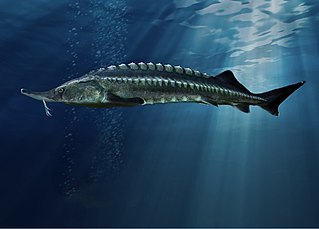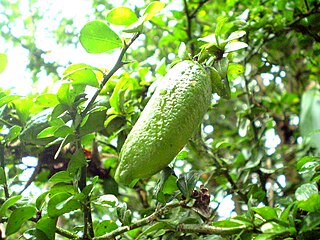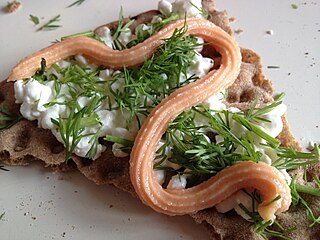Caviar, sometimes Kaviar is, primarily, the name given to the luxury delicacy consisting of processed, salted, non-fertilized sturgeon roe.
Contents
Caviar may also refer to:
Caviar, sometimes Kaviar is, primarily, the name given to the luxury delicacy consisting of processed, salted, non-fertilized sturgeon roe.
Caviar may also refer to:

Sturgeon is the common name for the 28 species of fish belonging to the family Acipenseridae. The earliest sturgeon fossils date to the Late Cretaceous, and are descended from other, earlier acipenseriform fish, which date back to the Early Jurassic period, some 174 to 201 million years ago. They are one of two living families of the Acipenseriformes alongside paddlefish (Polyodontidae). The family is grouped into four genera: Acipenser, Huso, Scaphirhynchus, and Pseudoscaphirhynchus. Two species may be extinct in the wild, and one may be entirely extinct. Sturgeons are native to subtropical, temperate and sub-Arctic rivers, lakes and coastlines of Eurasia and North America.

Roe or hard roe is the fully ripe internal egg masses in the ovaries, or the released external egg masses, of fish and certain marine animals such as shrimp, scallop, sea urchins and squid. As a seafood, roe is used both as a cooked ingredient in many dishes, and as a raw ingredient for delicacies such as caviar.

Caviar is a food consisting of salt-cured roe of the family Acipenseridae. Caviar is considered a delicacy and is eaten as a garnish or spread. Traditionally, the term caviar refers only to roe from wild sturgeon in the Caspian Sea and Black Sea. The term caviar can also describe the roe of other species of sturgeon or other fish such as paddlefish, salmon, steelhead, trout, lumpfish, whitefish, or carp.

Ajvar is a condiment made principally from sweet bell peppers and eggplants. The relish became a popular side dish throughout Yugoslavia after World War II and is popular in Southeast Europe.

Beluga caviar is caviar consisting of the roe of the beluga sturgeon Huso huso. The fish is found primarily in the Caspian Sea, which is bordered by Iran, Azerbaijan, Kazakhstan, Russia, and Turkmenistan. It can also be found in the Black Sea basin and occasionally in the Adriatic Sea. Beluga caviar is the most expensive type of caviar, with market prices, ranging from $7,000 to $22,000/kg.

The beluga, also known as the beluga sturgeon or great sturgeon, is a species of anadromous fish in the sturgeon family (Acipenseridae) of order Acipenseriformes. It is found primarily in the Caspian and Black Sea basins, and formerly in the Adriatic Sea. Based on maximum size, it is the third-most-massive living species of bony fish. Heavily fished for the female's valuable roe, known as beluga caviar, wild populations have been greatly reduced by overfishing and poaching, leading IUCN to classify the species as critically endangered.

Heliciculture, commonly known as snail farming, is the process of raising edible land snails, primarily for human consumption or cosmetic use. The meat and snail eggs a.k.a. white caviar can be consumed as escargot and as a type of caviar, respectively.

The shovelnose sturgeon is the smallest species of freshwater sturgeon native to North America. It is often called hackleback, sand sturgeon, or switchtail. Switchtail refers to the long filament found on the upper lobe of the caudal fin. Shovelnose sturgeon are the most abundant sturgeon found in the Missouri River and Mississippi River systems, and were formerly a commercially fished sturgeon in the United States of America. In 2010, they were listed as threatened under the U.S. Endangered Species Act due to their resemblance to the endangered pallid sturgeon, with which shovelnose sturgeon are sympatric.

Citrus australasica, the Australian finger lime or caviar lime, is a thorny understorey shrub or small tree of lowland subtropical rainforest and rainforest in the coastal border region of Queensland and New South Wales, Australia.

The starry sturgeon also known as stellate sturgeon or sevruga, is a species of sturgeon. It is native to the Black, Azov, Caspian and Aegean sea basins, but it has been extirpated from the last and it is predicted that the remaining natural population will follow soon due to overfishing.
Culinary names, menu names, or kitchen names are names of foods used in the preparation or selling of food, as opposed to their names in agriculture or in scientific nomenclature. The menu name may even be different from the kitchen name. For example, from the 19th until the mid-20th century, many restaurant menus were written in French and not in the local language.

The Persian sturgeon is a species of fish in the family Acipenseridae. It is found in the Caspian Sea and to a lesser extent the Black Sea and ascends certain rivers to spawn, mainly the Volga, Kura, Araks and Ural Rivers. It is heavily fished for its flesh and its roe and is limited in its up-river migrations by damming of the rivers. Young fish feed on small invertebrates, graduating to larger prey such as crabs and fish as they grow. The threats faced by this fish include excessive fishing with the removal of immature fish before they have bred, damming of the rivers, loss of spawning areas and water pollution. The International Union for Conservation of Nature has listed the fish as critically endangered and has suggested that the increased provision of hatcheries could be of benefit.

The Siberian sturgeon is a species of sturgeon in the family Acipenseridae. It is most present in all of the major Siberian river basins that drain northward into the Kara, Laptev and East Siberian Seas, including the Ob, Yenisei Lena, and Kolyma Rivers. It is also found in Kazakhstan and China in the Irtysh River, a major tributary of the Ob. The species epithet honors the German Russian biologist Karl Ernst von Baer.

The Russian sturgeon, also known as the diamond sturgeon or Danube sturgeon, is a species of fish in the family Acipenseridae. It is found in Azerbaijan, Bulgaria, Georgia, Iran, Kazakhstan, Romania, Russia, Turkey, Turkmenistan, and Ukraine. It is also found in the Caspian Sea. This fish can grow up to about 235 cm (93 in) and weigh 115 kg (254 lb). Russian sturgeon mature and reproduce slowly, making them highly vulnerable to fishing. It is distinguished from other Acipenser species by its short snout with a rounded tip as well as its lower lip which is interrupted at its center.
Beluga may refer to:

Smörgåskaviar is a fish roe spread eaten in the Nordic Countries. Despite its name, smörgåskaviar is not actual caviar, i.e. sturgeon roe. Instead, it is a paste made from cod roe and a variable mix of other ingredients, which can include potato flakes, tomato sauce, onion, salt and sometimes dill or chives. It is usually sold in smoked and non-smoked variants, as well as in variants with a prominent taste of dill.

Red caviar is a caviar made from the roe of salmonid fishes, which has intense reddish hue. It is distinct from black caviar, which is made from the roe of sturgeon.

Snail caviar, also known as escargot caviar or escargot pearls, is a type of caviar that consists of fresh or processed eggs of land snails. It is a luxury gourmet speciality produced in France and Poland. They were also a delicacy in the ancient world, also known as "Pearls of Aphrodite" for their supposed aphrodisiac properties.

The Caviar of Kladovo was a type of caviar produced in eastern Serbia. It was named after the town of Kladovo, central town in the Serbian part of the Danube's Iron Gates Gorge between Serbia and Romania. Made from various fishes' roe, the caviar was granted the protected geographic designation decades ago, and was considered an expensive delicacy, which was even served on the RMS Titanic. With the construction of large dams in 1972 and 1984, jointly by two states. the fishes migrating from the Black Sea upstream the Danube were prevented from reaching their old spawning areas and the production of the caviar was discontinued in the 21st century.